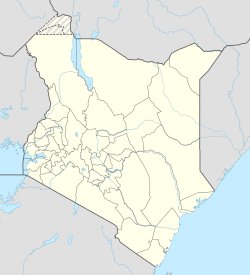
Back ثيكا ARZ تیکا، کنیا AZB Thika Catalan Thika (lungsod) CEB Thika German Thika EO Thika Spanish تیکا FA Thika French Thika Croatian

Thika | |
|---|---|
| Coordinates: 01°03′S 37°05′E / 1.050°S 37.083°E | |
| Country | |
| County | Kiambu County |
| Population (2019) | |
• Total | 279,429 |
| Time zone | UTC+3 (EAT) |
| Climate | Cwb |
Thika (Gikuyu: [ˈθika]) is an industrial town and commerce hub in Kiambu County, Kenya, lying on the A2 road 42 kilometres (26 mi), northeast of Nairobi, near the confluence of the Thika and Chania Rivers. Although Thika town is administratively in Kiambu County, the greater Thika area comprising residential areas such as Bendor estate, Maporomoko, Thika Greens, Thika Golden Pearl, Bahati Ridge, and Thika Sports Club, among others, are within Murang'a County. Thika had a population of 279,429 as of the 2019 National Census and is growing rapidly. Its elevation is approximately 1,631 metres (5,351 ft).
Thika is home to Chania Falls and Fourteen Falls on the River Athi. Ol Donyo Sabuk National Park lies to the southeast. The town has a railway station with limited passenger service as only cargo trains operate, although there are plans to extend the proposed light rail system to Thika.
The town was the headquarters of Thika West district following the split of the larger Thika district (created in 1994) into five districts: Ruiru, Gatundu, Gatanga, Thika East and Thika West. It was the seat of the South Central regional commissioner (deputy Provincial Commissioner) for Central Province appointed by the then President Mwai Kibaki in 2009 who was in charge of the larger Kiambu, Thika and Murang'a districts. However, under Kenya's new constitution, which recognizes only the 47 districts in existence as at 1992 as semi-autonomous counties, Thika town falls under Kiambu County while some residential areas of Thika are in Murang'a county. Although Kiambu Town is the county headquarters, Thika Town has the largest economy in Kiambu County.
The Flame Trees of Thika (Memories of an African Childhood) is a book by Elspeth Huxley, later adapted for television by Euston Films for Thames Television. It describes the life of English and Scottish settlers in the "White Highlands" during Edwardian times.
